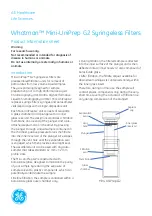
Pilot Valve Operation (Electric Models Only) __________________________________________
The main function of the pilot valve is to control the operation of the main
valve located in the base of the sprinkler body. The main valve is operated
by the release of water metered through the pilot valve when it is activated
either manually at the sprinkler or by the irrigation system controller.
Another important function of the pilot valve is to regulate the water
pressure to the sprinkler nozzle. Pressure regulation compensates for large
variations within the system and maintains a constant pressure for optimum
sprinkler operation. The pilot valve is factory set to regulate one of four
pressure levels 50 psi (3.4 bar), 65 psi (4.5 bar), 80 psi (5.5 bar) or 100
PSI (6.9 bar).
Change the pilot valve operating pressure by loosening the thumb screw
that secures the selector lever. Position the selector lever to the desired
operating pressure and hand-tighten the nut. See
Figure 12
.
Troubleshooting __________________________________________________________________
Pilot Valve
PROBLEM
POSSIBLE CAUSE – CORRECTIVE ACTION
Sprinkler will
(a) No 24 VAC to solenoid assembly. (Electric Models)
not turn on
– Measure voltage with a Digital Volt Meter (DVM). Check wiring and controller program.
– Refer to Controller Operating Instructions.
(b) Selector cam in "OFF" position.
– Set to "AUTO" position.
(c) Debris in pilot valve assembly.
– Disassemble and remove all debris. (See Servicing Pilot Valve page 12.)
(d) Insufficient pressure in controller supply line and/or sprinkler control tube. (N.C. Models)
– Check pressure.
Sprinkler will
(a) Constant 24 VAC from controller. (Electric Models)
not shut off
– Check for voltage using a DVM. If voltage is present, disconnect wire.
If sprinkler closes, service controller. Refer to Controller Service Manual.
(b) Selector cam in manual "ON" position.
– Set to "AUTO" or "OFF" position.
(c) Debris in pilot valve assembly.
– Disassemble and remove all debris. (See Servicing Pilot Valve page 12.)
(d) Constant pressure from controller. (N.C. Models)
– Check pilot valve at controller for constant flow.
– Check elevation differential. Valve elevation should not exceed 0' above
controller elevation or 70' (21.3 m) below controller elevation.
Sprinkler Mechanism
PROBLEM
POSSIBLE CAUSE – CORRECTIVE ACTION
Sprinkler won't rotate
(a) Debris wedged between stator and turbine.
– Remove obstruction.
(b) Drive assembly defective.
– Replace drive assembly.
(c) Nozzle base assembly defective.
– Replace nozzle base assembly.
Head sticks up
(a) Dirt in riser assembly.
– Flush out. (See Flushing Procedure on page 12.)
(b) Damaged or missing return spring.
– Replace.
(c) Damaged riser.
– Replace.
Poor distribution pattern
(a) Nozzle plugged with debris.
– Clean or replace nozzle.
(b) Nozzle orifice damaged.
– Replace nozzle.
(c) Low operating pressure.
– Determine why system overloaded and correct.
5
A U
T O
O N
Figure 12
100 PSI
(7.0 kg/cm
2
)
80 PSI
(5.6 kg/cm
2
)
65 PSI
(4.6 kg/cm
2
)
50 PSI (3.5 kg/cm
2
)



























